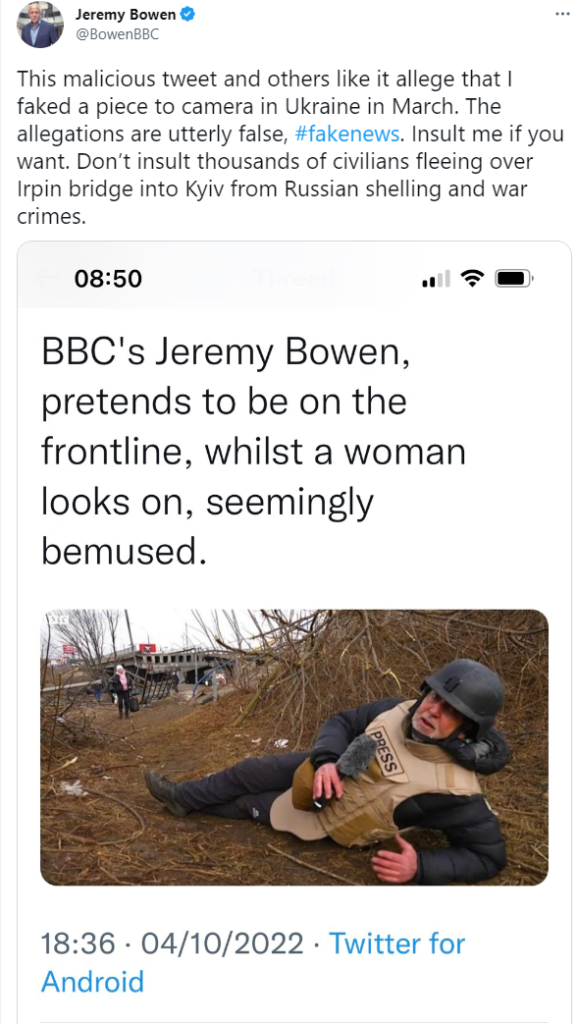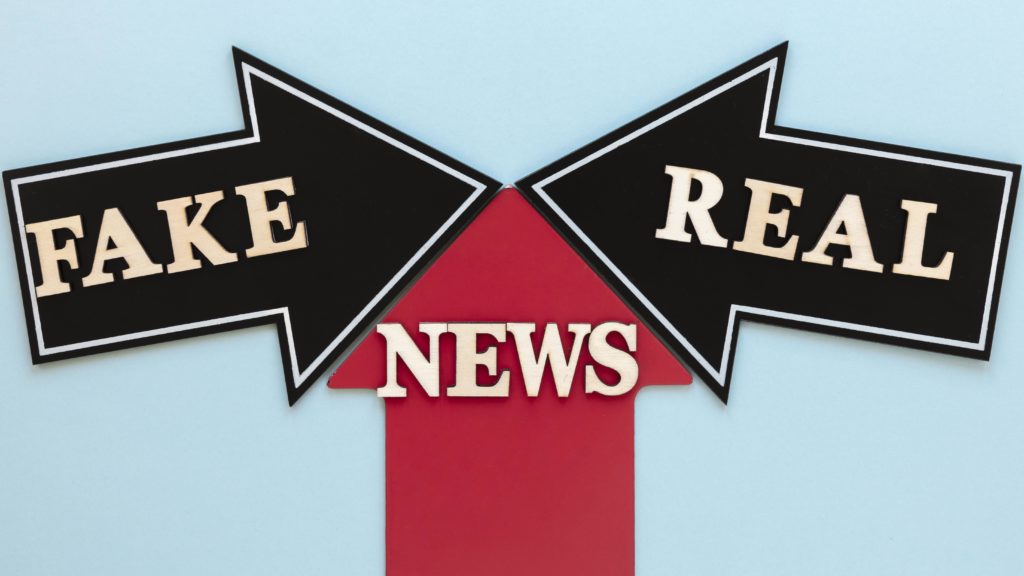Original article (in Bosnian) was published on 26/10/2022
A photo spreading on social networks was presented as proof of Western propaganda and the directing of war events in Ukraine, which was also shared by the Russian embassy in Bosnia and Herzegovina on its Facebook page.
On October 5, a photo collage was published on Twitter, consisting of four photos showing a male person with the word “press” on his body armour and a microphone in his hands. In the background, you can also see a woman holding a bag, who is said to be “going shopping” while the journalist is “reporting from the trenches”.
A “heroic” BBC journalist “reports” from the trench while a woman in a pink blouse walks past him and goes shopping! Journalism! 🤡

These photos and the description are used to insinuate that the collage is proof that the BBC journalist while reporting on the war in Ukraine, exaggerates the danger he is in and falsifies the war environment.
The same collage on this social network was shared on several other accounts, with similar descriptions insinuating the same and stating that the collage shows a journalist “reporting heroically from the trenches while an ordinary woman in a pink sweater goes about her business” (link, link, link).
We also found the photo on Facebook, where it was published on several profiles, pages and groups, with the description that it shows how “a BBC reporter delivers his heroic report ‘from the trench’ under fire, while a stunned woman from a nearby ‘trench’ understands what is happening here” (link, link, link, link).
The same collage was published by the Embassy of the Russian Federation in Bosnia and Herzegovina on its official Facebook page, with explicit claims that it represents evidence of “directing shows” and an example of “Western propaganda”:
How Western propaganda works:
➡️ BBC journalist delivers his heroic report “from the trench”, while the surprised woman from the nearby “trench” does not understand what is happening.
📌 In this way, “independent” media companies force everyone to believe in the reality of directed shows.
Where are the photos from?
The photos that make up the collage are scenes from a BBC video report published on March 6 on the site of this media company. They took place in Irpin, and the description of the video states that Russian air and artillery attacks on this town caused severe damage and that one woman and two children died while trying to escape.
Small towns near Kyiv, including Irpin, were under attack by Russian forces from the first days of the Russian invasion of Ukraine. After the intensified shelling of Irpin, many citizens decided to leave the city. Eight people died during the evacuation, and other media reported this in early March (link, link).
The BBC video report also states that journalist Jeremy Bowen spent a day in this city and warns that his report contains disturbing images of civilian casualties.

The video lasts a little longer than three and a half minutes, and at 1:52, you can see a reporter lying on the ground and reporting, as well as a woman with a bag in her hands in the background. It was this shot that was shared on social networks as “proof” that Bowen exaggerates the danger of the situation he is in, and that the woman, who is claimed to be “going shopping” or “going about her business,” was also surprised by his behavior.
However, the rest of this video attachment denies these insinuations and claims. The report actually shows the evacuation of civilians while explosions and gunshots are heard in the background, and the video also contains shots of the victims. The video first shows the moments of the explosions as the civilians took cover, and some of them crouched down, like the woman in the background of the video. When the explosions died down, the civilians in the video got up and continued to move towards the journalists, which is precisely the shot being shared on social networks.
So, it is clear from the report that the journalist is really reporting from the war zone and that the woman in the photo is just one of the many depicted evacuated victims fleeing the city while the attacks continue.
As this collage was shared in different languages in October as evidence that a BBC journalist was pretending to be on the front line, Jeremy Bowen used his Twitter account to refer to these allegations:
This malicious tweet and others like it allege that I faked a piece to camera in Ukraine in March. The accusations are utterly false, #fakenews. Insult me if you want. Do not insult the thousands of civilians fleeing over Irpin bridge to Kyiv from Russian shelling and war crimes.

Other fact-checking web portals such as Full Fact, Facta, AP, AFP-Proveri, AFP – cinjenice (facts), Open and USA today wrote about the manipulation of these photos. AFP-facts contacted Bowen himself, who called the claim from social networks a malicious fabrication.
According to the facts, we evaluate the claims that “a BBC journalist reports from a trench while a woman in a pink blouse goes shopping” or “goes about her business” as fake news.
The same claims are rated as manipulation of facts, given that they are based on an authentic photograph presented incorrectly and out of context.

